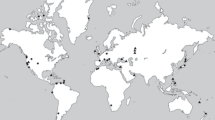Abstract
About 250 million years ago the continents were close together and formed Pangaea, a supercontinent, which persisted for about 100 million years and then fragmented. The landmasses at that time were located predominantly in the southern hemisphere. The climate was arid and dry; the average temperature is thought to have been several degrees higher than at present. This was one of the time periods in the history of the Earth, when huge salt sediments formed. A total of about 1.3 million cubic kilometers of salt were deposited during the late Permian and early Triassic period alone (Zharkov 1981). The thickness of the salt sediments can reach 1000 to 2000 meters. When Pangaea broke up, land masses were drifting in latitudinal and Northern direction. Mountain ranges such as the Alps, the Carpathians and the Himalayas were pushed up due to the forces of plate tectonics. The salt deposits in Austria originated in the Alpine basin, which extended from Innsbruck to Vienna. Some salt mines in the Alps are still in operation, and these were the sources of our samples. In the Alpine basin and in the Central European basin (Zechstein sea), no more salt sedimentation took place after the Triassic period; however, in other locations, e.g. in Poland, significant salt deposits were still formed until about 20 million years ago. Dating of the salt deposits by sulfur-isotope analysis (ratios of 32S/34S as measured by mass spectrometry), in connection with information from stratigraphy, indicated a Permo-Triassic age for the Alpine and Zechstein deposits, which was independently confirmed by the identification of pollen grains from extinct plants in the sediments (Klaus 1974).
Access this chapter
Tax calculation will be finalised at checkout
Purchases are for personal use only
Preview
Unable to display preview. Download preview PDF.
Similar content being viewed by others
Refrences
Denner, E.B.M., McGenity, T.J., Busse, H.-J., Grant, W.D., Wanner, G. and Stan-Lotter, H. (1994) Int. J. Syst. Bacteriol. 44:774–780.
Klaus, W. (1974) Carinthia II, 164, Jahrg 84: 79–85.
McCord, T.B., Mansen, G.B., Fanale, F.P., Carlson, R.W., Matson, D.L., et al. (1998) Science 280:1242–1245.
McGenity, T.J., Gemmell, R.T., Grant, W.D., and Stan-Lotter, H. (2000) Environ. Microbiol. 2:243–250.
Radax, C., Gruber, C. and Stan-Lotter, H. (2001) Extremophiles 5:221–228.
Stan-Lotter, H., McGenity, T.J., Legat, A., Denner, E.B.M., Glaser, K., Stetter, K.O. and Wanner, G. (1999) Microbiology 145:3565–3574.
Stan-Lotter, H., Pfaffenhuemer, M., Legat, A., Busse, H.J., Radax, C. and Gruber, C. (2002) Int. J. System. Evol. Microbiol. 52: 1807–1814.
Stan-Lotter, H., Radax, C. Gruber, C., Legat, A., Pfaffenhuemer, M., Wieland, H., Leuko, S., Weidler, G., Kömle, N. and Kargl, G. (2003) Int. J. Astrobiol. 1:271–284.
Treiman, A.H., Gleason, J.D. and Bogard, D.D. (2000) Planet. Space Science 48:1213–1230.
Whitby, J., Burgess, R., Turner, G., Gilmour, J. and Bridges, J. (2000) Science 288:1819–1821.
Zharkov, M.A. 1981. History of Paleozoic Salt Accumulation. Springer Verlag, Berlin.
Zolensky, M.E., Bodnar, R.J., Gibson, E.K., Nyquist, L.E., Reese, Y., Shih, C.Y. and Wiesman, H. (1999) Science 285:1377–1379.
Author information
Authors and Affiliations
Editor information
Editors and Affiliations
Rights and permissions
Copyright information
© 2004 Springer Science+Business Media Dordrecht
About this chapter
Cite this chapter
Stan-Lotter, H. et al. (2004). Viable Halobacteria from Ancient Oceans—and in Outer Space?. In: Seckbach, J., Chela-Flores, J., Owen, T., Raulin, F. (eds) Life in the Universe. Cellular Origin and Life in Extreme Habitats and Astrobiology, vol 7. Springer, Dordrecht. https://doi.org/10.1007/978-94-007-1003-0_43
Download citation
DOI: https://doi.org/10.1007/978-94-007-1003-0_43
Publisher Name: Springer, Dordrecht
Print ISBN: 978-1-4020-3093-2
Online ISBN: 978-94-007-1003-0
eBook Packages: Springer Book Archive




